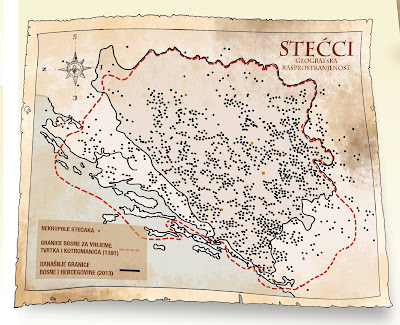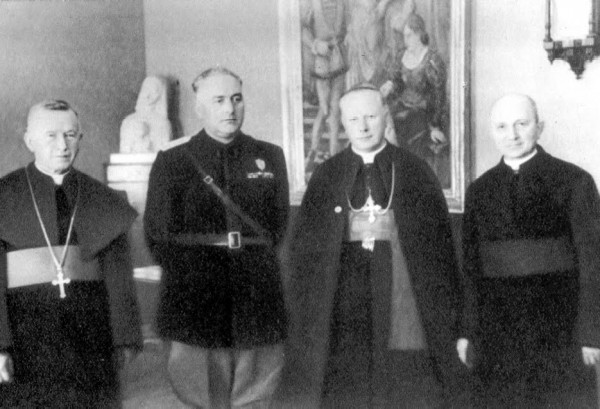The historical "bridge" between Romanians and Dalmatian Italians
There was a continuum of romance speaking populations in Europe at the end of the Western Roman Empire, from Portugal and Spain to France and Italy: this continuum reached the Balkans until the Danube river delta, from Italian Istria until the Romanian Dobrugia.
But actually there it is a "hole" of this continuum in the area that was former Yugoslavia (Slovenia, Croatia, Bosnia-Herzegovina and Serbia), because of the Slav invasions that happened during the early Middle Ages. However for many centuries this hole between Italy and Romania was partially occupied by a kind of "bridge" of neolatin populations (usually called "Vlachs", a word from latin 'vallum', meaning 'people of the Roman vallum' near the barbarian borders of the Western Roman empire) during the late Middle Ages until the Renaissance centuries. These Vlachs lived in the mountains of the western Balkans, but were slowly "assimilated" by the Slavs and actually they have practically disappeared, leaving only some evidences of themselves in the names of the Balkan topography & history (like "Romanija", "Stari Vlah", etc..).
Map showing the remains of the "Bridge" (Romanija Planina & Stari Vlah) in the XIII century, between the neolatin territories of Ragusa Republic & Spalato of the Dalmatian Italians and those of the Valko (Vojvodina) & Kucso (Timok)
Indeed Ilona Czamańska wrote in "Vlachs and Slavs in the Middle Ages and Modern Era” (Res Historica, 41, (Lublin, 2016), 19) that: "The majority of Serbs from the Republika Srpska of modern Bosnia is of Vlach origin, as well as the majority of the population from Bosnia and Herzegovina in general." This fact is clearly related to the historical bridge -now disappeared- that existed until the Middle Ages between the romance speaking Romanians and the Italian populations in Dalmatia and Istria.
The following are excerpts -related to this "bridge"- from an essay written by Octavian Ciobanu (Professor of Iasu University) and titled "The Heritage of Western Balkan Vlachs":
A lot of Latin or Vlach place names still resist until today in Western Balkans. Jirecek wrote about the Vlach impressive presence in Montenegro, Herzegovina and Dalmatia in a period which lasted from the XIIIth to the XVIth centuries.The Serbian documents from the 12th to the 15th centuries revealed a large number of Vlach placenames and Vlach personal names which are still in use by the Slavs of the Western Balkans. The Romanian character of the language of these Vlachs is generally recognized.
According to Stelian Brezeanu, among the toponyms attesting the presence of the Romanic element in the region, there are two that have an importance: Palaioblacoi and Stari Vlah. Palaioblacoi is attested in Thessaly (later Μεγάλη Βλαχία/Megali Vlahia) and the second toponym, Stari Vlah, is attested in the Medieval Serbia and in Herzegovina: “It was a region inside of the Kingdom of the Nemanids that attached the Kopaonik Mountains to the Romanija Mountains, around the city of Sarajevo. That region had as centre the Drina and the Lim rivers valley.”
Next to Stari Vlah it is Romanija. This area has the mountain still called Romanja.Therefore, the region of Stari Vlah belonged to a more extended area, intensively romanised at the end of the antiquity.Ştefan Stareţu writes that “it is clear that Stari Raska comes from Stari Vlaska, with a rothacism, and Raska from Vlaska (this is exemplified by the double name of Banat, as Vlaska or Raska)”. He also advances a hypothesis: “The Serbs and Vlachs are probably a single ethnic substance, constructed in the Balkan Peninsula as a unity in the 8th-14th century.”
Furthermore, according to Ilona Czamańska the Vlach population was already established in the western Balkans during the migration of Slavs. But she pointed out that both ethnic groups occupying the same land were not in conflict. Slavs, as farmers, occupied lands in the valleys, which were suitable for them, while Vlachs exploited mountains. Slavs, next to agriculture, also engaged in breeding, but did not practice transhumance pastoralism, which was the domain of the Vlachs. For the Slavs the land and the right to its cultivation and ownership was most important, for the Vlachs the ownership of land did not matter as long as the mountains were common property. The element, which bound their community together, was not the land, but family relationships and the sense of belonging to the same "clan".
In the Middle Ages the Vlachs lived in most of the mountain areas in the western Balkans up to the Adriatic coast. In the Middle Ages, the territory between the rivers Lim and Drina in the west, and Raska and Studenica in the east, was called “Old Wallachia” (Stari Vlah), and the Orthodox Church province of the Rasca – “eparchy Old Wallachian”.
In the Serbia of the Nemanjić dinasty (1166-1371) and the states that have later arisen on its ruins, the Vlachs created a fairly closed community because of their special privileged status, in contrast to the rest of Slavic peasant population. Mixed marriages with representatives of other social classes, especially the peasant population, were very difficult here. Despite that, here the processes of Slavisation and assimilation proceeded very quickly. It was also facilitated because of the vanishing of the areas where the Vlach shepherds could wander, because of the distribution of the mountain areas to particular owners. Vlachs defended themselves against dependence for example by buying pastures, which resulted in their definitive transition to semi-sedentary and sedentary life.
The Knez and provincial governors (often Vlach ones) became major landowners, entering the group of nobles and even the aristocracy of Serbia. Among the Slavic Balkan rulers many had Vlach roots – most probably the families Balšić, Hrvatinić – Kosača, and perhaps also Mrnjavcević. Already the earliest records of the names of the Vlachs as well as the names of localities preserved in the sources of the 13th century show a hybrid combination of Vlach and Slav element. Even then, many Vlach names were Slavic, often with Romanian endings (i.e. Dragul, Radul and Bogdan and afterwards even Milutin, Vukašin and Momcil).
Starting from the 14th century the term “Vlach” began to lose its ethnical meaning in favour of a societal meaning in the areas of Serbia and Bosnia and Herzegovina. In these areas the Vlachs were strongly mixed with the Slavic population and the name “Vlach” was frequently used interchangeably with the term “Slav”.
In the "bridge", Slavisation (in fact Serbisation) of the Vlachs was also encouraged by the period of the Ottoman rule. As Orthodox, Vlachs belonged to the same millet as Serbs, and after the reconstruction of the Serbian Patriarchate of Peć they were subordinated to civil authority of the Serbian patriarch. Thus, Vlachs were integrated with Serbs very quickly, especially that the religious affiliation was the main identifier. The persons who belonged to the Serbian Orthodox Church were called by the name of Serbs, not only in the lands which were traditionally Serbian, also in Bosnia. This process was intensified by the fact that many Vlachs abandoned their activities, especially since enclosed social classes did not exist in the Ottoman state.
Actually -according to Marian Wenzel- the majority of the population from Bosnia and Herzegovina in general is of Vlach origin.
Map showing the location (with small points) of the 'Stecci', medieval funerary monuments, in an area that is very similar to the one of the "historical bridge". Note that the easternmost 'Stecci' are located in Serbia's "Stari Vlah" and the westernmost are near the Republic of Venice's Zara area (linking -as a kind of "bridge" through Serbia and Bosnia/Herzegovina- western Romania and Italy's Dalmatia)
Indeed the medieval Vlachs (called often Aromanians) of Herzegovina are considered authors of the famous funerary monuments with petroglyphs (usually called "Stecci") from Herzegovina and surrounding countries. The theory of the Vlach origin of these 'Stecci' was proposed by Bogumil Hrabak (1956) and Marian Wenzel and more recently was supported by the archeological and anthropological researches of skeleton remains from the graves under these 'Stećci'. For Wenzel the Vlachs did not continue to create other 'Stecci' since their conversion -in the sixteenth century- to moslem religion because of Turks domination.
The theory is much older and was first proposed by Arthur Evans in his work "Antiquarian Researches in Illyricum" (1883): while doing research with Felix von Luschan on 'Stecci' graves around Konavle, he found that a large number of skulls were not of Slavic origin but similar to older romanised Illyrian population, as well as noting that Ragusa memorials recorded those parts inhabited by the Vlachs until the 15th century. In other words: these 'Stecci' made by neolatins confirm the existence of this "bridge" betweeen Dalmatia and "Stari Vlah"
Last but not least, we have to remember that in the area of southern Croatia and internal Dalmatia these Vlachs -who were present in the early Middle Ages- were called 'Maurovlachs', or 'Morlachs'(Morlacchi) by the Italians, and they relatively quickly succumbed to Slavisation and Catholic faith. They differentiated themselves from the rest of society through their social status, which took on a special meaning in these lands. In the 17th and 18th centuries the term 'Morlachs' determined both Slavisised Vlachs from the area of Dalmatia, as well as Croatian peasants who were mixed with Dalmatian Italians (and who actually speak a croatian dialect -called "Chacavian"- that has more than 50% of words loaned from latin & romance languages).
 |
| Map showing the actual 'neolatin gap' between Italy and Romania, that from Istria & Dalmatia reached western Romania's Timok region trough Herzegovina, Romanija and Stari Vlah. |
However -according to Italian historians like Della Volpe- a legacy of this "bridge" can be seen in the existence of the Republic of Bosnia & Herzegovina, populated mainly by descendants of the romanised populations who created the worldwide famous "Stecci" (read for further information on the Stecci: https://www.scribd.com/doc/34362364/Marian-Wencel-UKRASNI-MOTIVI-NA-STE%C4%86CIMA ).














.jpg)


